Notions of Japaneseness in Western Interpretations of Japanese Garden Design, 1870s-1930s
Published January, 2014
Pages 1-25
DOI: http://dx.doi.org/10.21159/nv.06.01
New Voices
Volume 6
© The Japan Foundation, Sydney, 2014
Permalinks for references are available in the HTML version of this article.
Abstract
Aesthetic imaginings of Japan have stereotypically revolved around notions of beauty and restrained simplicity. Thus, the concept of Japaneseness’ is imputed into what is commonly understood as Japanese design’. This article explores the way in which the idea of Japaneseness’ has developed by focussing on one area of the nation’s art and design: the landscape garden. Particularly, it considers the way in which the interpretations of Westerners between the 1870s and 1930s contributed to the dissemination of ideas of a quintessential Japanese garden aesthetic. It argues that such ideas resulted in images of gardens in Japan being embedded in the premodern rather than modern, and also contributed to a tendency for the notion of what is Japanese’ to be essentialised to a single construct, one which existed as Other to a superior West.
Introduction
Japanese design’ has become such a widely used catchphrase that its meaning is hardly ever questioned in non-academic circles. In areas as diverse as fashion, graphics and architecture, the Japanese have become recognised as design leaders as much as technological leaders.1 But what are the style elements that emerge from the products of these designs? Do they constitute something which can be termed Japanese’? And how did the idea of a distinctively Japanese style or aesthetic evolve?
This paper explores the idea of Japaneseness’ in Western cultural discourse on Japan by focussing on one area of the nation’s art and design: the landscape garden. Particularly, it considers the way in which Westerners between the 1870s and 1930s viewed the Japanese garden and the notions of Japaneseness promoted through their interpretations. While there is a concentration of Western academic research considering the question of Japanese cultural identity in architecture in Japan,2 discourse on the subject of Japaneseness in the context of the landscape garden is limited. This article explores the influence of five significant Westerners—Christopher Dresser, Edward Morse, Josiah Conder, Bruno Taut and Christopher Tunnard—who visited or lived in Japan between the 1870s to 1930s and recorded their observations of Japanese gardens. Other than Morse, who was a trained scientist, each of these men was a professional in architecture, design or horticulture, and each communicated their impressions to Western audiences by public lectures or published work. This article argues that these authorities promoted the idea of a pure Japanese garden involving essential characteristics of beauty, simplicity and spirituality. It is submitted that many of these ideas were grounded in premodern images and did not reflect the reality of the emerging modern Japanese society. Further, it is argued the dissemination of such ideas contributed to the creation of aesthetic stereotypes as to what is Japanese’. These perceptions continue to inform the popular cultural identity of Japan in the West.
The period from the 1870s to the prewar 1930s has been chosen as the focus for this analysis because it is the earliest period of concentrated Western commentary on Japanese garden design. This paper does not analyse the influence of Japanese authorities on the development of a Japanese identity within landscape garden design. This forms another large and complex area of research which is beyond the scope of this article.
Japanese Design
It has become common for people in Japan and outside to generalise about characteristics of Japanese style. Elements such as simplicity, functionality and minimalism have been talked about in such a way that Westerners now understand Japanese design as a distinctive mix of all these elements. In an essay titled Why Japan?’, J.V. Earle identifies two stylistic stereotypes of Japanese design: one colourful, decorative, exuberant and inventive (as depicted in woodblock prints); and the other monochrome, linear, refined and austere (as seen in traditional arts such as tea ceremony, architecture and gardens).3 The latter intersects with wabi, sabi and shibui, a complex set of notions expressed in the tea ceremony and the lyrical poetry of the Heian imperial court4 which embody qualities such as restraint, simplicity, purity and the expression of spirituality through minimal aesthetic means’.5 The popular Western conception of a Japanese garden invokes many of these ideals. It also invokes notions of harmony and a special Japanese affinity with the natural world, each of which has become part of a general rhetoric in the West for describing things Japanese. The development of this imagery in the context of the Japanese garden will be examined in this article.
Western Interpretations of the Japanese Garden, 1868-1912
The availability of garden imagery from Japan was limited, but not absent, in the West prior to the Meiji era (1868-1912). As early as the 1600s, knowledge of Japanese gardens had travelled to Europe through pictures and botanical specimens collected by German physicians working in Nagasaki with the Dutch East India Company, resulting in an influx of Japanese plants into European gardens.6
However, it was not until the latter half of the nineteenth century that Western architects frequented Japan and began to influence Europe and America with their views on garden design. Determined to prove Japan’s strength and capability to Western nations, the new Meiji government had embarked on a rapid period of modernisation which, in its view, meant a mass program of Westernisation. This project took place across all areas of Japanese life. In the field of architecture, the government commissioned the construction of large Western-style buildings and employed Western specialists to visit Japan and train local architects.7 During their time in Japan, these specialists, together with experts from non-architectural fields, observed Japanese gardens and disseminated aesthetic ideas that influenced the way Japanese gardens were appreciated in the West.
Christopher Dresser (1834-1904) was the first European designer to visit Japan as part of the Meiji government’s modernisation scheme.8 Self-described as an architect and ornamentist’,9 Dresser was invited as a guest of the government for four months in 1876-77 to advise on the modernisation of the nation’s art industries.10
Although not a garden design specialist, Dresser was an expert in botany, and his book, Japan—Its Architecture, Art, and Art Manufactures, published in London in 1882, contains many vivid descriptions of gardens and scenery. Dresser was a powerful figure in late nineteenth-century European design and the Japonisme movement, and the text is considered one of only a few significant first-hand Western accounts of architecture in Japan during the Meiji era.
The designer introduces himself with authority:
An apology is needed for adding to the number of our books on Japan. We have heard of the ways of the Japanese, of the peculiarities of their manner, of their feasts and festivals, of the food they eat, and of the aspect of the country in which they live. My excuse for writing is a simple one—I am a specialist.11
This all-assuming self-introduction establishes a hierarchical relationship between the specialist Dresser and the peculiar’ race he intends to study. He plants the latter firmly in notions of the exotic and curious: strange articles of food, strange people, strange objects meet the eye on every side…Indeed it would be difficult to describe the impression of novelty left in our minds.’12
It is from this Orientalist vantage point that Dresser gives his account of the native style’, an expression used frequently throughout the book to describe Japanese custom.13
Dresser was overwhelmed by what he perceived as a country of great beauty, declaring, everything is so pure, so clean and so thoroughly Japanese’.14 The purity of the immaculate summit of Japan’s peerless cone’ (Mount Fuji), the charming gardens and teahouses, picturesque bridges, and an air of cleanness and beauty create for Dresser a picture of the Japanese people as genial and loving’.15 He constructs the Japanese garden in idyllic notions of beauty and purity:
On the moat outside the castle hundreds of wild ducks were floating. In the moat I saw leaves and bent seed capsules of the beautiful Nelumbrum or Buddhist water-lily.16
The garden surrounding the palace is a lake of the greatest purity, a running stream, and small waterfall…17
These romantic articulations of tranquil harmony ignore several historical realities. Many famous gardens in Japan were built during periods of war and social upheaval, negating any suggestion of them being places of purely harmonious and spiritual value. Further, political and imperial power were often important motivations for the construction of gardens in premodern Japan, and accounted for the changing uses of gardens over time. For example, in the Nara period (710-794), government and aristocrats utilised Buddhism as a political tool, rendering Buddhist gardens and temples places of prayer for the protection of the State, and disconnecting them from the common people.18 In the Muromachi (1398-1573) and Edo (1603-1868) periods, gardens were built by shoguns primarily as symbols of wealth and power and had relatively little connection with worship or spirituality.19 The garden at Nijō Castle (and the castle itself) and the Tōshōgū Shrine in Nikkō are examples of this kind of construction.
For Dresser, the Tōshōgū Shrine is the most beautiful of all the shrines in Japan’.20 Dresser is largely referring to the highly ornamental architectural features of the shrine, reminiscent of Victorian tastes. However, he also addresses the surrounding gardens. References to the mountain river and stream of delicious water’, the great sanctuary’ and images of birds, flowers and clouds carved into the enclosure walls21 are evocative of a harmonious paradise and romantic beauty. These images stand in juxtaposition to the shrine’s significance as a symbol of political authority. Construction of the grand, baroque shrine was a self-deifying act by the founding Tokugawa ruler, Ieyasu, whose attempts to rival the sacred claims of the imperial court included the capture of an imperial prince at the shrine.22 Ieyasu was later buried in the shrine’s grounds.
Dresser also applauded a perceived harmony between the Japanese people and nature: There seems to be in Japan a harmony between man and the lower creatures such as I had never before seen’.23 The idea of the Japanese people having a special affinity with nature is a central stereotype within claims of Japanese uniqueness, and one that has only recently come under critical attack.24 Authors Pamela Asquith and Arne Kalland dismiss the idea of such a unique relationship, stating, the Japanese have—like most other people, the Chinese included—an ambivalent attitude towards nature in which their love and veneration is only one dimension’.25 It is outside the scope of this article to explore questions of a special Japanese affinity with nature. However, Dresser’s idealist comments are an early example of the way the idea of a special Japanese love of nature and a corresponding ability of the Japanese to live harmoniously with nature were transmitted by a Western authority.
Dresser was instrumental in the establishment of a Japanese village at North London’s Alexandra Park in 1875, providing the British public with their first real view of a Japanese garden.26 The garden was in fact part of the exhibit from the 1873 Vienna World Exposition which Dresser had purchased under the banner of his recently established importing venture, the Alexandra Park Company, and re-erected in London.27 Unfortunately, records of the village are scant. Pictorial images show a garden with a summer house, pavilion, stone lantern and bridge over an artificial pond (Figures 1 & 2). It is also believed to have included a Shinto shrine.28 These were all structures which appealed to the British thirst for the curious and exotic. This exoticism was enhanced by the surrounding representations of domestic life of remote nations’,29 including a Moroccan harem and an Egyptian house where one might have believed they were drinking coffee in Cairo’.30
In his study of the modern Japanese garden, Toshio Watanabe notes that Japanese gardens were a regular feature at major international exhibitions from the 1870s to the 1960s.31 According to Watanabe, these large-scale international exhibitions attracted audiences in the millions and were instrumental in constructing imagery of Japanese culture within Europe.32 By 1878, Japanese artefacts were high fashion in Europe and readily available in retail stores,33 while the Japanese tea garden had become popular in middle-class English homes.34 Japan fever was such that, by 1885, a second Japanese village was constructed at South Kensington. Watanabe claims that the garden was probably the most significant phenomenon of twentieth-century Japonisme.35
Dresser’s views of Japanese art and architecture were fundamental in promoting Japanese art culture as a serious subject of study during the late nineteenth century.36 By 1879, he was the most active and well-known promoter of Japonisme in Britain and the largest importer of Japanese wares through his personal trading business.37 He also wielded significant influence in the United States, conducting lectures and interacting with high-profile trade officials and retailers, most notably the jeweller Tiffany and Co. However, he did so from a European Orientalist standpoint which subordinated the objects he appraised to the quaint’ and curious’,38 thus reinforcing European hegemony in Anglo-Japanese relations.
In the context of decorative art, Anna Jackson has criticised Dresser’s views, stating they are based on an unshakeable belief in the ultimate superiority of Western civilisation’ and imply backwardness on the part of the Japanese.39 She has also criticised Dresser’s ideas as reflecting an escapist longing by those coming to terms with the complexities of life in the industrialised West’.40 This statement resonates in the light of Dresser’s romantic portrayal of garden beauty described above. Jackson’s criticisms contrast with the view of Widar Halén, who asserts that Dresser was instrumental in removing the false hegemonic barriers between Western and Oriental art’.41 It is this author’s contention that, while Dresser actively sought to illustrate the value of Japanese art to the Euro-American art world, he did so by entrenching that value in the traditional, not the modern. By fixing imagery of Japanese gardens in the past and seeking the preservation of those aspects of simplicity and purity he so admired, Dresser confined an emerging progressive nation to a static place of relative inferiority. As Elizabeth Kramer notes, nineteenth-century Western commentators on Japanese art possessed:
a desire to preserve a romantic view…that Japan was inhabited by a people who were by their very nature artistic, whose exotic and singular art was regarded as authentic and of high quality as long as it remained untouched by the introduction of industrial means or market demand.42
Dresser’s references to a thoroughly Japanese’ and purely Japanese’ character contributed to the idea that there was such a thing as a Japanese style which could be understood independently as a national aesthetic. This was so, despite his constant likening of Japanese design to Indian, Greek, Egyptian and Chinese styles and his attempts to discern the influences of Buddhism on Japanese art and architecture.43
Dresser’s views must also be considered in the context of his 1876-7 visit, which was arranged entirely by a new Meiji government eager to impress its Western guest. The tour included visits to esteemed Shinto sites such as Ise Shrine, an audience with the Meiji Emperor, and the rare privilege of viewing the imperial collections in Nara and Kyoto.44 Dresser’s views on Japanese beauty must, therefore, be seen within the highly constructed context of an official agenda promoting government (and imperial) interests. The itinerary limited Dresser’s tour to elite residences and gardens, failing to provide him with a balanced view of the architecture and gardens of which he so confidently spoke.
Dresser’s commercial interests also add scepticism to his motives. Kramer states that Dresser had much to gain personally in terms of cultural capital’ for his business, design and literary ventures by visiting Japan.45
In a market hungry for Japanese art, it was financially lucrative to position oneself as knowledgeable of Japanese art and culture and to produce objects inspired by Japan.46
Four years after the publication of Dresser’s book, the American zoologist, archaeologist and collector Edward Morse (1838-1925) published Japanese Homes and their Surroundings, a work now considered to be the first detailed Western study of Japanese architecture.47 The book discusses the architectural features of Japanese houses, devoting a whole chapter to the garden.
Originally visiting Japan to study brachiopods, Morse was offered a post as chair of zoology at the Imperial University of Tokyo (1877-80), during which time he became fascinated with the Japanese house and garden. Morse was impressed by what he perceived as the simplicity of the Japanese garden, stating that:
The secret in a Japanese garden is that they do not attempt too much. That reserve and sense of propriety which characterizes this people in all their decorative and other artistic work are here seen to perfection… [I]n Japan [plots of ground] are rendered charming to the eye by the simplest means.48
Morse’s impressions stem from a broader base than Dresser’s. Unlike Dresser, who attended only Japan’s grandest gardens and shrines, Morse visited a range of gardens including imperial and private gardens, those of merchants and priests, and also those of the lower and middle classes. However, Morse’s commentary retains much of the Orientalist flavour of Dresser’s book. Like the Japanese house, which Morse describes as a peculiarly characteristic dwelling’,49 his construct of the Japanese garden possesses a peculiar charm’50 embedded in quaint features such as little rustic shelters’, the delightfully conceived’ twist of vines51 and little promontories with stone lanterns’52 (Figures 3 & 4). He patronises the Japanese with direct statements such as: the nation is poor, and…the masses are in poverty…for this reason a Japanese builds such a house as he can afford’.53 Like Dresser, who painted the Japanese as a curious race, Morse’s descriptions have a subordinating effect. They reinforce ideas of Western superiority, simultaneously imposing a medieval backwardness on the Japanese which was inconsistent with modern reality.
Morse’s construction of the Japanese garden also includes elements of the sacred and poetic, embedding Japaneseness in the spiritual and refined. For example, Morse quotes the inscription of a legend on a rock tablet from an Omori tea garden famous for its plum blossoms (Figure 3):
The sight of the plum-blossom causes the ink to flow in the writing-room’— meaning that one is inspired to compose poetry under the influence of these surroundings.54
Morse was writing at a time of enormous technological and social change in Japan. In the fifteen years preceding his book, Japan had successfully installed its first telegraph line as well as completed a railway link between Tokyo and Yokohama.55 Morse is aware of these changes yet chooses to cast images of Japaneseness in terms of an ancient romantic idealism completely disconnected from the landscape of the modern age.
His nostalgic commentary connotes the imaginings of a people accomplished in composition and calligraphy—pastimes which, at least until Edo times, were the precinct of the cultured nobility and spiritual elite, not the common classes.56
Morse admired the Japanese ability to construct miniature gardens, and promoted the rustic elements of garden construction.57 However, his predominant image of the Japanese garden was of the charming and picturesque, conjuring up romantic notions of ancient legends and poetry. He rejected the jigsaw’ effect of American gardens and the horrors’ of the taundry glint and tinsel’ in the over-decorated dwellings of middle-class American homes which reflected his country’s urban reality.58 Instead he seemed to find escapism in a traditional view of Japanese gardens that constituted not only an exotic charming other’ but also a refreshingly pleasant romantic image of the simple and pure.
This notion of simplicity in Japanese gardens was strengthened through the teachings of Josiah Conder (1852-1920), an English architect invited to Japan in 1877 to design Western-style buildings for the Japanese government, and who also became a professor at Tokyo’s Imperial College of Engineering. Conder led the design of several large modern buildings including the Imperial Museum (1882) in Ueno, Tokyo, and the famous Rokumeikan dance hall (1880-1883), also in Tokyo, earning him a reputation as the father of modern Japanese architecture’.59 In 1893, after 16 years in Japan, Conder wrote Landscape Gardening in Japan, a seminal work which brought ideas on the relationship between landscape and architecture in Japan to the West.60
Conder’s views on gardens projected a Japanese essence: a closeness to nature, simplicity, cleanliness and refinement. He saw the Japanese as unrivalled in their genuine love of nature’ and possessing a manner of observation and enjoyment…peculiar to themselves’.61 Conder was impressed with the Japanese garden and house as a blended concept and the integration of indoor and outdoor areas through the use of sliding fusuma screens and open matted rooms. He was possibly the first person to bring Japanese ideas on the relationship of garden and architecture to Western attention.62
Conder described the Japanese ideal of beauty as being expressed in asymmetry, as opposed to the fundamentally alien’ aesthetic of geometrical patterning employed in Western gardens.63 He also perceived nature as representing an ideal beauty in which the pine tree, plum tree, mountain, lake and waterfall were the standards.64 The wilder state of gardens which had fallen into disrepair appealed to his tastes for the irregular and ideals of purity. Of Kyoto’s fourteenth-century Kinkakuji Temple he said, in one spot was a mossy nook from which welled up a natural spring of the purest water’,65 while the fifteenth-century Ginkakuji Temple was described as a place of lotuses and wooded hills with a bubbling spring of the purest water’66 (Figures 5 & 6). Conder’s projection of these gardens as peaceful wellsprings of pure, untamed beauty ignored historical realities. Kinkakuji Temple was a massive display of wealth comprising ten buildings and a seven-storey pagoda built by the shogun Ashikaga Yoshimitsu, and Ginkakuji Temple was a self-indulgent palace constructed by Yoshimitsu’s grandson, Yoshimasa, during the post-Ōnin War poverty and social chaos in Kyoto.67
Conder emphasised purity as a Japanese element of garden design. He noted that Japanese gardens were rarely disfigured by hybrid and incongruous elements’ as compared with the exotic but unfamiliar combinations of nineteenth-century English gardens.68 He believed careful consideration of aesthetic elements such as scale, proportion, unity, balance and congruity, together with the avoidance of overcrowding or embellishment and the consistent use of materials from within Japan allowed the Japanese gardener to achieve a simplicity and purity of style.69 He spoke of the profound serenity resulting when a clever artistic balance between rocks, hills and water was achieved,70 and praised the unified single composition’ which he believed gave Japanese art a rank and importance surpassing other styles.71
Conder identified aesthetic elements of extreme simplicity’, a scrupulous cleanliness’ and the appearance of antiquity’ in the tea garden, describing the tea ceremony itself as the cultivation of simplicity and gentleness of manners’.72 He also observed functionality in the use of garden stones, such as the ability to support a kettle, candlestick or lantern, or the use of a hollow stone for the washing of hands.73 He noted that tea gardens expressed different sentiments but shared a common character of wilderness and sequestered solitude’.74
For Conder, the Japanese garden was at once a picture and a poem’, a place of retreat for secluded ease and meditation’ reflecting the temperament, sentiments and occupation of the owner.75 Thus, the garden of a priest or poet may express a character of dignified solitude, virtue, and self-denial’, while a samurai’s garden should be of bold, martial character’.76
Conder’s construction of the Japanese garden in terms of idealised beauty, simplicity and serenity depicted Japan as a nostalgic place where poets and priests led philosophical lives among rocks and lakes representing natural elements. Even his image of a samurai-owned garden was an outdated one of stylised heroism, the samurai having been a military force under the previous Tokugawa shogunate and occupying a considerably less-powerful and relatively impecunious position under the new Meiji regime. His vision of purity can be seen as a nostalgic rejection of modern European landscape design, which he saw as creating a confused variety of fanciful scenes’ vulgar to the eye.77
In her book Discourses of the Vanishing, Marilyn Ivy discusses the question of Japan’s national-cultural identity in terms of a search within Japan for a lost past or a vanishing auratic’.78 She argues that assertions of a pure or unique Japanese national-cultural identity have in part been driven by desires to preserve tradition in the face of an age of electronic reproduction.79 She cites the Noh theatre and tea ceremony as examples of Japan’s refined high culture’ which have been preserved by the Japanese as icons of Japaneseness.80 Thus, she says, nostalgia for the premodern is an appealing motivator for the preservation of tradition and the assertion of a traditional national-cultural identity in the modern age.
I would argue that this logic can be applied to Western observations of Japan’s garden landscape during the late nineteenth and early twentieth centuries. That is, in the same way that repetitions of traditional practice in Japan today act as reminders to the Japanese of a time when tradition played a significant role, premodern images of a poetic, spiritual and beautiful Japan appealed to the nostalgic need of Western architects to revisit their own lost pasts and, in so doing, escape the realities of a more caustic industrial age. Susan Napier makes this connection in a literary context when she states:
[A] kind of aesthetic utopia’ can be found in premodern Japan in The Tale of Genji which speaks nostalgically of a vanished world of an elite in possession of aesthetically, if not morally, superior accomplishment.81
Conder was pioneering in his promotion of Japanese concepts such as indoor-outdoor architecture. However, he trivialised the complex and sophisticated web of influences that had come to bear on Japanese landscape design through his use of expressions such as a charming system of ethics’ and a quaint philosophy’.82 This had the effect of subordinating the very art he so admired.
Western Interpretations of the Japanese Garden, 1912-1930s
European architects continued to visit Japan in the early twentieth century. Notably, these include the Czech Antonin Raymond, who assisted Frank Lloyd Wright with the construction of the Imperial Hotel, and Viennese-born Richard Neutra.83 However, it is the German architect Bruno Taut (1880-1938) whose writings are most instructive in relation to Japanese gardens. Fleeing Nazi Germany, Taut arrived in Japan in 1933 where he spent three years employed as an advisor to the Industrial Arts Research Institute. His writings concentrate predominantly on the architectural structures in Japanese gardens, only referring incidentally to the gardens themselves, but are significant in their creation of new meanings for what was considered Japanese.
Taut was the first foreign architect to critically question what was essentially Japanese and acknowledge Korean and Chinese influences on Japanese arts. In a forthright lecture on Japanese architecture presented to the Kokusai Bunka Shinkōkai in 1935, he declared Japan’s era of exoticism over, claiming prehistoric artefacts had failed to reveal any peculiar Japanese characteristics in craftsmanship or in the design of houses. Rather, Taut asserted that the houses pictured on these artefacts bore features shared with those of other countries such as the Scandinavian nations and Germany.84
For Taut, the closest example of indigenous Japaneseness came in the form of Ise Shrine, which he declared to be the most Japanese’ of all things in Japan.85 This was the first time Ise’s architectural beauty had been openly praised by a Western visitor.86 He placed the shrine on a par with the Parthenon, noting its simplicity and supreme use of natural materials, as well as its functionalist value.87 The blending of landscape and architecture provided an authenticity which appealed to Taut. Jonathan Reynolds observes that the way the buildings at Ise harmonised with their natural surroundings stood in stark contrast to the artifice of European Victorian architecture’.88
Similarly, Taut declared the seventeenth-century Katsura Villa and gardens in Kyoto an eternal beauty’89 representing the standard Japanese architecture for the world’:90
Only at Katsura does there exist that overwhelming freedom of intellect which does not subordinate any element of the structure or the garden to some rigid system.91
In contrast, Taut categorised the structures of Tōshōgū at Nikkō—praised so heavily by Dresser fifty years before—as bad art’ bearing an overabundance of ornamentation and ostentation’ and undigested importation’92 (Figure 7).
Taut has been criticised for pursuing a utopian image of serenity and natural beauty consistent with tradition rather than with twentieth-century architectural practice.93 According to McNeil, Taut deplored Japan’s urban modernity, labelling the post- earthquake buildings of Tokyo which mixed European and Japanese styles as hideous monstrosities.94 Thus, rather than ignoring Japan’s modernisation as the late Victorian observers had, Taut vilified’ it.95
Taut’s influence was significant in drawing a distinction between what was honmono (authentic) and ikamono (kitsch),96 or as Taut put it, the critical question … as to which elements of Japan’s culture are essentially Japanese in character and which are not’.97 In so doing he created new codes for describing Japanese architecture. Taut contributed to a devaluation of the heavily decorated style of Tōshōgū Shrine98 and a new aesthetic appreciation for the simpler, cleaner styles of Ise Shrine and Katsura Villa.99
Taut’s views coincided with the growing idealisation of imperial rule in Japan during the 1930s,100 as well as new thinking on the concept of Japaneseness. It is outside the scope of this paper to discuss the internal promotion of ideas of uniqueness by the Japanese themselves. However, it is worth mentioning that the projection of the value of beauty by Taut contributed to an aesthetic re-evaluation within Japan, which in turn created new benchmarks for what was internally promoted as Japanese.
Finally, I would like to discuss the influence of Canadian-born, British-trained horticulturist Christopher Tunnard (1910-1979). Tunnard is regarded in America as the first major educator on the subject of Japanese gardens in the English-speaking world.101 In Britain his work was also influential, although it did not receive the same positive attention there as in the United States.102
Tunnard worked with Wells Coates, an architectural engineer born in Japan. Influenced by Bernard Leach’s teachings on Eastern art and Conder’s Landscape Gardening in Japan,103 Tunnard expressed his views on Japanese landscape gardening in a series of articles written in 1937 for the British Architectural Review. These formed the basis for his book, Gardens in the Modern Landscape, published the following year. In a section titled The Oriental Aesthetic’,104 Tunnard hailed the Japanese as possessing a genius for building’ and exercising great skill’ in the use of native materials, spatial management and distribution of rooms.105 Like Conder, Tunnard praised the sliding-folding window for breaking down the rigid barrier between house and garden’106 (Figures 8 & 9). He implored modern Western architects to change their ideology, declaring, our gardens have a new mission—to fulfil the need for an affinity with Nature’.107
Like Conder, Tunnard compared the asymmetrical design of Japanese gardens with the symmetrical layout of European landscape gardens. He saw beauty as Taut had in unembellished design, praising the simplicity and uncluttered quality of Japanese rooms which he contrasted with the bulging Victorian curio cabinet’.108 He also praised the restrained use of colour in Japanese gardens which he believed contributed to an extreme simplicity of effect’.109
However, Tunnard’s overriding praise was for the Japanese ability to merge identity with nature and to unify habitation within the environment.110 Thus, he supported the idea of the garden as a place for use as much as visual appeal. He called for European gardens and landscapes to be humanised’ in accordance with needs of the twentieth century and appealed to European designers to discard the old clothes’ of the past age and absorb the Oriental aesthetic’.111
Despite his outwardly modernist views, Tunnard reinforced traditional ideas of simplicity, beauty and spirituality in his formulation of the Japanese garden. He also re-emphasised the notion of a special Japanese affinity with nature, stating, the truth which the Orient now reveals is that his identity is not separate from Nature and his fellow-beings, but is at one with her and them’.112
Thus, like Dresser, Tunnard perpetuated a way of thinking that intertwined Japanese aesthetics with the idea of an intrinsic Japanese affinity for nature. This essentialism has been well-touted in theories of Japanese uniqueness (nihonjinron). However, as Tessa Morris-Suzuki articulates in her chapter on nature in Re-Inventing Japan, the relationship between the Japanese and their natural surroundings cannot be reduced to a single essentialism.113 In the Edo period, she asserts, there were differences in opinion among Japanese thinkers as to the human relationship with nature, with one school viewing man and nature as one, and the other seeking to utilise the natural world for economic benefit.114
Tunnard continued Orientalist rhetoric by proclaiming there was such a thing as an Oriental aesthetic’ and positioned the Oriental’ in opposition to the European’ in his commentary. Unlike Taut, he did not question external influences on the Japanese design, thereby perpetuating the idea of a singular Japanese style.
Conclusion
Western authorities between the 1870s and 1930s defined the Japanese garden as possessing a number of aesthetic values. These included beauty, simplicity, refinement, functionality, rusticity, spirituality and harmony. In so doing they fixed notions of Japaneseness within traditional boundaries, evoking images of Heian-period court life and Buddhist and Shinto rituals. In this way, characteristics such as beauty and refinement, which were appropriate descriptions for Heian gardens, were transcribed to an appreciation of gardens in the modern era. Further, the values of a narrow cultured elite were generically grafted onto a modern Japanese society operating in a new technological age. The aesthetics of Japanese beauty and simplicity appealed to these architects who were seeking alternatives to the British mid-nineteenth-century obsession with the Gothic revival’.115
The perception of Japanese gardens as gentle, clean and harmonious places conjuring up romantic associations of noble court life and spirituality presented a welcome contrast to the mass production and urban realities of European and American industrialised cities. In projecting their views of Japaneseness in landscape design, what became defined as modern in the international world was actually the highly traditional.
In continually using terminology such as Japanese design’, Japanese style’ or the Oriental aesthetic’, Western authorities contributed to the development of the idea of the Japanese garden as a singular, unitary construct possessing a distinctive cultural style. They ignored historical realities, such as the influence of Buddhism and other Chinese influences on landscape design in Japan, which make the concept of a purely Japanese garden style an impossibility. Taut came the closest to identifying an indigenous Japanese style in the Shinto-based architecture of Ise. In so doing, he rooted Japaneseness in the premodern rather than the modern, a conception that was to prove highly influential in the international architectural movement in the mid-1900s.116
The changing values and meanings associated with gardens in Japan render any attempt to ascribe essential aesthetic characteristics such as spirituality, simplicity and beauty to a singular notion of a Japanese garden futile. Gardens in Japan have been used for different purposes, with different levels of spiritual connection and varying philosophical bases. Before 1600, they were the precinct of the cultured elite, government and religious groups, and had little connection with the common people. Thus, observations of premodern gardens—at least those created prior to the Edo period—cannot be used to draw assumptions about a general Japaneseness in gardens. These important distinctions have a strong bearing on how Western interpretations of the Japanese garden can be understood.
Narrowed to essentialisms, Western views of Japanese gardens promoted during the Meiji and prewar eras refuse to acknowledge many of the realities behind the beautiful facades of Japan’s gardens. In highlighting the relationship between garden and architecture, Western commentators reinforced the idea of the Japanese possessing a special affinity with nature.
The continual positioning of Japanese style against Western models also reinforced the notion of Japan as a unitary cultural construct only existing in relation to another construct, the West’. One way Edward Said defined Orientalism was in terms of an ineradicable distinction between Western superiority and Oriental inferiority’.117
It is questionable whether Said’s theory can be applied to Japan, a nation outside the scope of his Middle Eastern focus and one which was not subject to colonial or imperial rule by the West. However, to the extent that Said highlights the presumed authority and superiority Europeans adopted in their quest for knowledge about their (Middle) Eastern colonial subjects, his ideas do resonate to some degree with Western interaction with Japan during the Meiji and interwar eras.
In referring to the charming’ and quaint’, Western observers of Japanese gardens in the Meiji era suggested a way of thinking that perpetuated the notion of Japan as the Other, a curious and peculiar subject to be studied and known by an authoritative West. However, at the same time, these observers offered great praise for a Japanese style of garden, saluting many aspects which were not seen in Europe and, in many cases, encouraging Europeans to adopt the Japanese way. This admiration had the effect of elevating appreciation of Japanese architecture and landscape design both outside and within Japan and contributing to the incorporation of many Japanese features into modern architectural and garden design in the Western world.
Acknowledgement
The author wishes to thank Professor Christopher (Rusty) Tunnard for kind permission to reproduce photographs by his father, Christopher Tunnard.
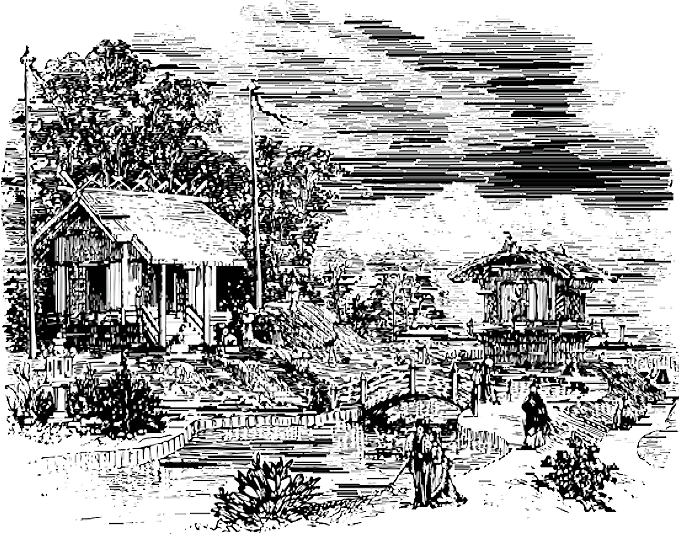
Figure 1. The Japanese village at Alexandra Park, 1875 (The Official Guide to the Alexandra Palace and Park, p. 2)
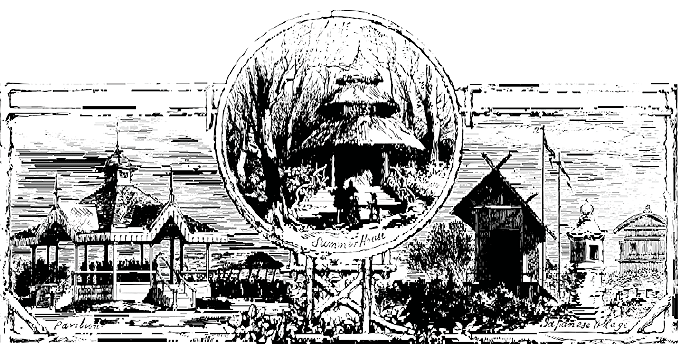
Figure 2. Summer house, pavilion and garden features from the Japanese village, Alexandra Park, 1885 (Archival material, Hornsey Library, London [detail])
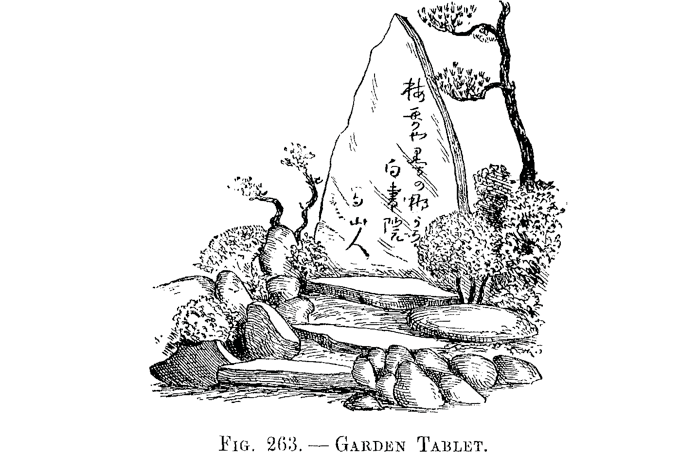
Figure 3. Garden tablet inscribed with legend (Morse, p.279)
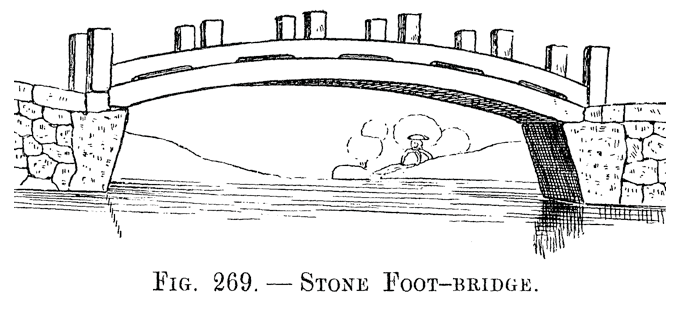
Figure 4. Example of rusticity’ and quaintness’: a garden bridge observed by Morse (Morse, p. 279)
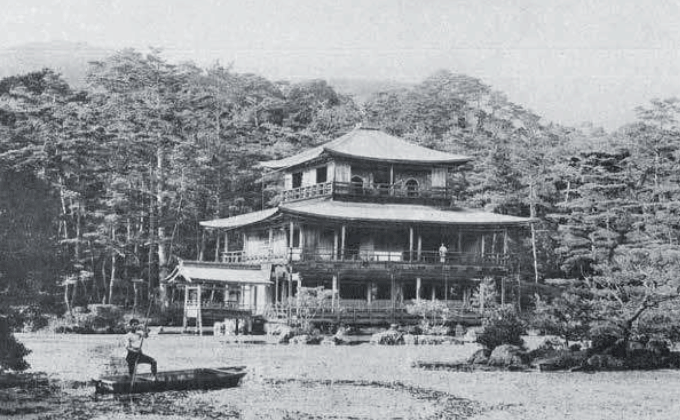
Figure 5. The romantic beauty of Kinkakuji Garden, as seen by Conder (Conder, Landscape Gardening in Japan,Vol. 2, Plate VIII)
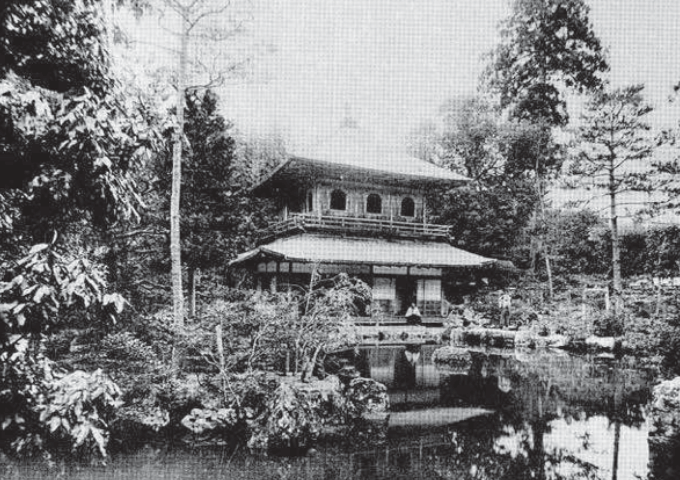
Figure 6. Lake and pavilion at Ginkakuji, as admired by Conder (ibid., Plate IX)
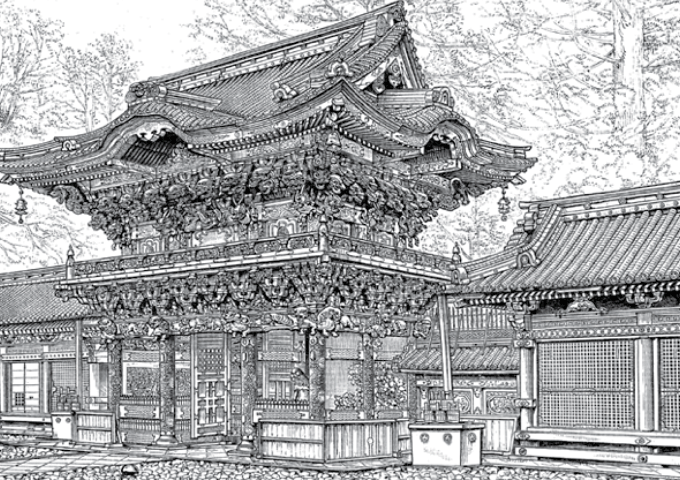
Figure 7. Heavy ornate detail of TÅshÅgÅ« Shrine in NikkÅ, decried by Taut as bad art’ (Dresser, p. 206)
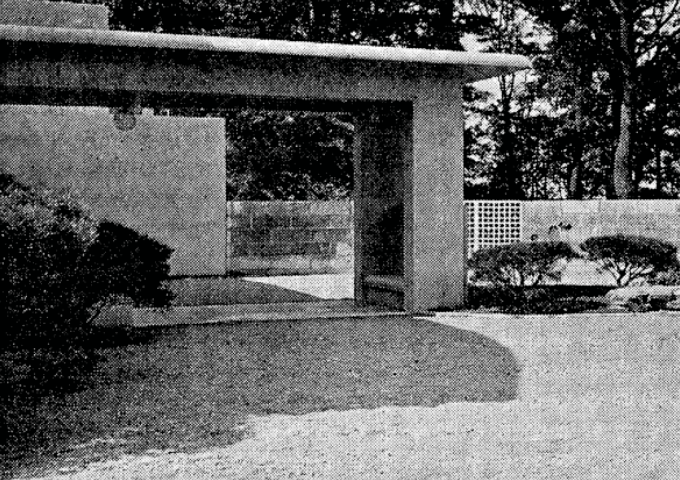
Figure 8. The blended indoor-outdoor style heralded by Tunnard (Tunnard, p. 89)
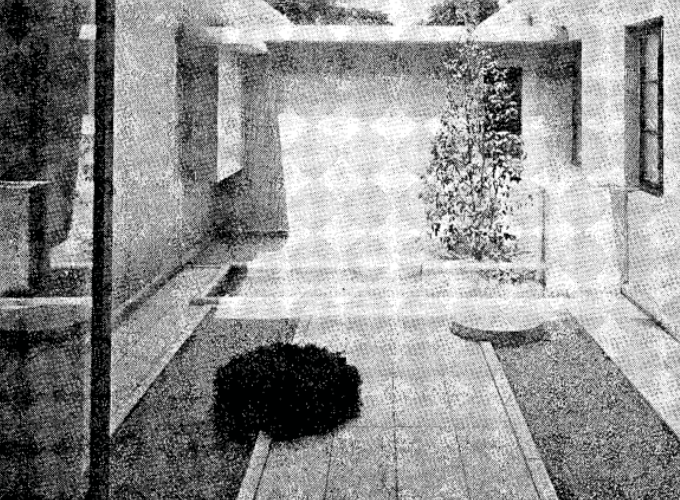
Figure 9. (As above)
Reference List
Asquith, P. J. and Kalland, A., Japanese Perceptions of Nature: Ideals and Illusions’, in Asquith, P. J. and Kalland, A. (eds.), Japanese Images of Nature: Cultural Perspectives (Richmond, Surrey: Curzon Press, 1997), pp. 1-35.
Basham, A. E., Dovetailing East and West: An Appraisal of Japonisme within the British Modern Movement through the Work of Wells Coates, Ph.D. thesis (University of the Arts London, 2007).
Bellah, R. N., Intellectuals and Society in Japan’, Daedalus, vol. 101, no. 2 (Spring 1972), pp. 89-115. Conder, J., Landscape Gardening in Japan, Vol. 1 (Tokyo: Hakubunsha, 1893).
Conder, J., Landscape Gardening in Japan, Vol. 2, Supplement (Tokyo: Hakubunsha, 1893).
Dresser, C., Japan, Its Architecture, Art, and Art Manufactures (London: Longman, Green & Co., 1882).
Earle, J. V., Why Japan?’, in Yoshida, M. et. al., Japanese Style: Essays (London: Serinda, 1980), pp. 12-16.
Fujioka, M., Kyoto Country Retreats (Tokyo: Kodansha, 1983).
Gordon, A., A Modern History of Japan (New York: Oxford University Press, 2003).
Goto, S., The Japanese Garden: Gateway to the Human Spirit (New York: Peter Lang, 2003).
Halén, W., Dresser and Japan’, in Whiteway, M. (ed.), Shock of the Old: Christopher Dresser’s Design Revolution (London: V & A, 2004), pp. 127-139.
Isozaki, A., Japan-ness in Architecture (Cambridge, Massachusetts; London: The MIT Press, 2006).
Ivy, M., Discourses of the Vanishing: Modernity, Phantasm, Japan (Chicago: University of Chicago Press, 1995),
http://dx.doi.org/10.7208/chicago/9780226388342.001.0001
Jackson, A., Imagining Japan: The Victorian Perception and Acquisition of Japanese Culture’, Journal of Design History, vol. 5, no. 4 (1992), pp. 245-256,
http://dx.doi.org/10.1093/jdh/5.4.245
Kramer, E., Master or Market? The Anglo-Japanese Textile Designs of Christopher Dresser’, Journal of Design History, vol. 19, no. 3 (2006), pp. 197-214,
http://dx.doi.org/10.1093/jdh/epl020
Kuitert, W., Themes, Scenes and Taste in the History of Japanese Garden Art (Amsterdam: J. C. Gieben, 1988).
Lambourne, L., Japonisme—Cultural Crossings between Japan and the West (London: Phaidon Press, 2005).
Lancaster, C., The Japanese Influence in America (New York: W. H. Rawls, 1963).
McNeil, P., Myths of Modernism: Japanese Architecture, Interior Design and the West, c.1920-1940′, Journal of Design History, vol. 5, no. 4 (1992), pp. 281-294,
http://dx.doi.org/10.1093/jdh/5.4.281
Morris-Suzuki, T., Re-Inventing Japan: Time, Space, Nation (New York: M. E. Sharpe, 1988).
Morse, E. S., Japanese Homes and their Surroundings, 2nd ed., (Vermont: Charles E. Tuttle Company, 1972).
Napier, S., The Logic of Inversion: Twentieth Century Japanese Utopias (Oxford: Nissan Institute of Japanese Studies, 1991).
The Official Guide to the Alexandra Palace and Park, 1875.
Reynolds, J. M., Can Architecture be both Modern and ”Japanese”?’, in Rimer, T. J. (ed.), Since Meiji: Perspectives on Japanese Visual Arts, 1868-2000 (Honolulu: University of Hawai’i Press, 2012), pp. 315-339. https://doi.org/10.21313/hawaii/9780824834418.003.0013.
Reynolds, J. M., Ise Shrine and a Modernist Construction of Japanese Tradition’, The Art Bulletin, vol. 83, no. 2 (2001), pp. 316-341,
http://dx.doi.org/10.2307/3177211
Said, E., Orientalism (London: Penguin, 2003).
Sparke, P., Modern Japanese Design (New York: E. P. Dutton, 1987).
Taut, B., Fundamentals of Japanese Architecture (Tokyo: Kokusai Bunka Shinkokai, 1936).
Tunnard, C., Gardens in the Modern Landscape (London: The Architectural Press, 1948).
Watanabe, T., The Modern Japanese Garden’, in Rimer, T. J. (ed.), Since Meiji: Perspectives on Japanese Visual Arts, 1868-2000 (Honolulu: University of Hawai’i Press, 2012), pp. 340-360. https://doi.org/10.21313/hawaii/9780824834418.003.0014.
Watanabe, T., Josiah Conder’s Rokumeikan: Architecture and National Representation in Meiji Japan’, Art Journal, vol. 55, no. 3 (1996), pp. 22-27,
http://dx.doi.org/10.1080/00043249.1996.10791766
Watanabe, T., Vernacular Expression or Western Style? Josiah Conder and the Beginning of Modern Architectural Design in Japan’, in Bowe, N. G. (ed.), Art and the National Dream: The Search for Vernacular Expression in Turn-of-the-Century Design (Dublin: Irish Academy Press, 1993), pp. 43-52.
The Alexandra Palace’, The Times, 27 April 1874, p. 9.
Untitled, undated newspaper extract from Alexandra Palace archives, Hornsey Library, London.

Claudia Craig
University of London, Birkbeck College
- Sparke, Modern Japanese Design, 49. ↩
- For examples, see Isozaki, Japan-ness in Architecture; McNeil, Myths of Modernism’; Watanabe, Vernacular Expression or Western Style?’; and most recently, Reynolds, Can Architecture be both Modern and ”Japanese”?’. ↩
- Earle, Why Japan?’, p. 12-13. ↩
- Kuitert, Themes, Scenes and Taste in the History of Japanese Garden Art, p. 239. For further discussion of these aesthetics, see pp. 228-255. ↩
- parke, op. cit., p. 13. ↩
- Lambourne, Japonisme, pp. 192-193. ↩
- Watanabe, Josiah Conder’s Rokumeikan’, p. 22. ↩
- Halén, Dresser and Japan’, 127. ↩
- Dresser, Japan, Its Architecture, Art, and Art Manufactures, p. 209. ↩
- Halén, op. cit., p. 132. Dresser himself states two further objectives of his visit: to bring the South Kensington Museum donation to the national museum in Tokyo, and to collect objects of art for his own personal Japanese collection and that of Tiffany and Co. ↩
- Dresser, op. cit., p. 209. ↩
- ibid, p. 9. ↩
- For example, Dresser describes his breakfast in Japan as a collection of native dainties’ and the straw sandals he wears as the native shoe’; ibid., pp. 4, 132. ↩
- ibid, p. 131. ↩
- ibid, p. 27. ↩
- ibid, p. 32. ↩
- ibid, p. 36. ↩
- Goto, The Japanese Garden, p. 69. ↩
- ibid.; Gordon, A Modern History of Japan, p. 35. ↩
- Dresser, op. cit., p. 198. ↩
- Dresser does not specifically refer to the garden itself but rather to an enclosure surrounded by walls’; ibid., p. 201. ↩
- Gordon, op. cit., pp. 14, 35. ↩
- Dresser, cit., p. 223. ↩
- See Asquith and Kalland, Japanese Perceptions of Nature, for a collection of essays dealing with questions of the Japanese relationship with nature. ↩
- ibid, p. 29. ↩
- The Japanese section at the 1862 International Exhibition in London did not include a garden. ↩
- Watanabe, The Modern Japanese Garden’, p. 348; Halén, op. cit., p. 131. ↩
- Watanabe, The Modern Japanese Garden’. ↩
- Untitled, undated newspaper extract, Alexandra Palace archives, Hornsey Library, Although the newspaper report is undated, its contents indicate that it is likely to have been published on or about 1 May 1875. ↩
- The Alexandra Palace’, The Times, 27 April 1874, p. 9. ↩
- Japanese gardens were featured at expositions in Vienna (1873), Philadelphia (1876, 1926), Paris (1878, 1889, 1900, 1925), Chicago (1893, 1933), Louis (1904), London (1875, 1910), San Francisco (1915, 1939), New York (1939-1940, 1964-1965), Brussels (1958), Seattle (1909, 1962) and Montreal (1967). See Watanabe, The Modern Japanese Garden’, p. 348. ↩
- ibid. ↩
- Halén, cit., p. 134; Kramer, Master or Market?’, p. 208. ↩
- Tunnard, Gardens in the Modern Landscape, p. 91. ↩
- Watanabe, The Modern Japanese Garden’, p. 349. ↩
- Halén, cit., p. 138. ↩
- ibid., pp. 135-7; Kramer, op. cit., p. 203. ↩
- Jackson, Imagining Japan’, p. 247. ↩
- ibid., p. 250. Jackson here was referring to images created by Dresser of Japanese craftsmen as simple, innocent, primitive Japanese’ who created beautiful objects as a labour of love. ↩
- ibid ↩
- Halén, op. cit., pp. 127-128. ↩
- Kramer, op. cit., p. 205. ↩
- Halén, op. cit., pp. 127, 138; Dresser, op. cit., pp. 37, 149, 203-204. ↩
- Halén, cit., p. 132-133. Dresser was accompanied to Japan by Japanese commissioners Sekisawa Akiko and General Saigo Tsugumichi. His visit was reported on by an official of the Japanese Home Office and later transformed into a book. ↩
- Kramer, cit., p. 200. ↩
- ibid.; Halén also claims that Dresser established his 1873 importing business with the aim of selling Japanese wares at the Japanese village at Alexandra Halén, op. cit., p. 131. ↩
- McNeil, op. cit., p. 281. Morse is said to have been influenced by Dresser’s passion for collecting Japanese art objects. Morse also collected Japanese ceramics and teaware. Halén, op. cit., pp. 133-134. ↩
- Morse, Japanese Homes and their Surroundings, p. 274. ↩
- ibid., p. xxxiii. ↩
- ibid., p. 285. ↩
- ibid., p. 280. ↩
- ibid., p. 285. ↩
- ibid., p. 10. ↩
- ibid., p. 276. Wording of the inscription is as translated in Morse’s book. ↩
- McNeil, op. cit., p. 282; Morris-Suzuki, Re-Inventing Japan, pp. 73-77. Japan installed its first telegraph line in 1869. The Tokyo-Yokohama railway line was completed in 1872. ↩
- Kuitert, op. cit., p. 258; Bellah, Intellectuals and Society in Japan’, pp. 90-91. In the Heian period (794-1192), the cultured nobility of the imperial court used gardens for boating, poetry composition and reading literature. Lyrical poetry was concerned with images of nature and gave an emotional dimension to plants, trees and other things of nature in the garden. In the ensuing Kamakura period (1192-1338), Zen Buddhist priests emphasised spirituality over elegant beauty and used their gardens for meditation rather than leisure activities. Even in the 17th century when tea gardens reached their popular peak, they were favoured by the urban elite rather than the common classes. Kuitert, pp. 254, 258. ↩
- Morse, op. cit., p. 285. ↩
- ibid., p. 348. ↩
- Watanabe, Josiah Conder’s Rokumeikan’, p. 22. ↩
- Basham, Dovetailing East and West, p. 71. Landscape Gardening in Japan was published in two volumes, Volume One containing text and plates, and Volume Two (known as the Supplement) containing plates only. ↩
- Conder, Landscape Gardening in Japan, 1, p. 2. ↩
- Basham, op. cit., p. 62. ↩
- Conder, op. cit., p. 166. ↩
- ibid., p. 2. ↩
- ibid., p. 22. ↩
- ibid., p. 23. ↩
- The Ōnin War (1467-1477) destroyed most of Kyoto, leaving many people starving. Ignoring the suffering of his people, Yoshimitsu built Ginkakuji Temple entirely for his own indulgent pleasures. Special features included a white sanded area from which he could view the garden by moonlight and indulge in fantasies of the moon and gods. In the process of construction of the palace, a graveyard was dismantled. Goto, The Japanese Garden, pp. 138-145. ↩
- Conder, op. cit., p. 6. ↩
- ibid., p. 7, 9. ↩
- ibid., p. 95. ↩
- ibid., p. 12. ↩
- ibid., p. 147. ↩
- ibid., p. 54. Conder also noted the religious meanings of particular stones as well as the attachment of auspicious meanings; ibid., pp. 46-55. ↩
- ibid., p. 17. ↩
- ibid., 9. ↩
- ibid. ↩
- ibid., p. 6. ↩
- Ivy, Discourses of the Vanishing, p. 12 ↩
- ibid. ↩
- ibid., p. 11. ↩
- Napier, The Logic of Inversion, p. 4. ↩
- Conder, cit., pp. 6, 8. ↩
- McNeil, cit., p. 282. ↩
- Taut, Fundamentals of Japanese Architecture, p. 14. ↩
- ibid., p. 15. ↩
- Previous Western visitors to Ise Shrine, such as Isabella Bird, Ralph Cram and Basil Chamberlain, had dismissed it as architecturally Reynolds, Ise Shrine’, pp. 320-321. ↩
- Isozaki, op. cit., p. 12. ↩
- Reynolds, op. cit., p. 321. ↩
- Taut, op. cit., p. 20. ↩
- ibid., p. 19. ↩
- ibid. ↩
- ibid., pp. 18-19, 21. ↩
- McNeil, op. cit., p. 192. ↩
- ibid., p. 284. ↩
- ibid., p. 282. ↩
- Isozaki, op. cit., p. 13. ↩
- Taut, op. cit., p. 14. ↩
- Isozaki, op. cit. ↩
- Ise Shrine had previously been valued as a religious symbol, while the Katsura Villa had never before been opened to the public and, therefore, had not been recognised. ↩
- ibid., p. 14. ↩
- Lancaster, The Japanese Influence in America, p. 190. ↩
- Basham, op. cit., pp. 182-3. ↩
- ibid., pp. 178, 180. ↩
- The title The Oriental Aesthetic’ appears in the original 1938 edition of Tunnard’s book but is omitted from the 1948 edition. Apart from the title, the contents of the Japanese section are identical in both editions. Page references in this paper have been taken from the 1948 edition. ↩
- Tunnard, op. cit., p. 89. ↩
- ibid., pp. 90-91. ↩
- ibid., p. 89. ↩
- ibid., p. 87. ↩
- ibid., p. 90. ↩
- ibid., p. 88. ↩
- ibid., p. 92. ↩
- ibid., p. 88. ↩
- Morris-Suzuki, op. cit., pp. 35-59. ↩
- ibid., pp. 40-46. ↩
- Sparke, op. cit., p. 26. ↩
- Lancaster, op. cit., p. 166. ↩
- Said, Orientalism, p. 42. ↩

